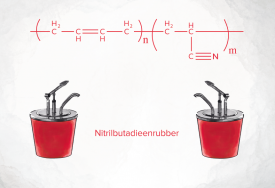What is NBR?

What is NBR? NBR (Nitrile Butadiene Rubber) is a synthetic rubber in which butadiene is the main constituent, with acrylonitrile as an important component. This grade of rubber is also called nitrile, and is ideally suited for making products that come into contact with mineral oils and fuels. NBR is also very tolerant of grease.
What is NBR?
NBR can withstand grease, lubricants, oil and various other hydrocarbons, as well as a number of dilute acids. NBR is often chosen for products because of its mechanical properties and widely applicable temperature range; it can withstand temperatures ranging from -20 to +100 °C. Although NBR is fairly resistant to ozone and UV radiation, this type of rubber is mostly found indoors.
NRB is impermeable to gases and can therefore be deployed in combination with aromatic compounds, ketones, strong acids and halogenated hydrocarbons.
NBR is less resistant to ageing and weathering. Check EPDM rubber or SBR rubber for grades of rubber that are resistant to ageing and weathering.
What is the application of NBR?
Thanks to its outstanding oil resistance, NBR is frequently used on oil platforms, in the petrochemical industry and in garages and workshops. This rubber is also used for gaskets and is the type of rubber most frequently used for O-rings.
The hygienic nitrile gloves used in the medical industry are a well-known example of the use of nitrile rubber, and NBR is also used in conjunction with greasy foodstuffs, for example, in mayonnaise pumps or the hoses in chocolate factories.
RIS Rubber frequently uses NBR for seals that may come into contact with oil. It is also used in the production of star sieves, clean room soles and rubber mats.
If you would like to know more about NBR and its applications, please feel free to get in touch with us or use our form to provide your contact details.

